
Hydropower, also known as water power, is the use of falling or fast-running water to produce electricity or to power machines. This is achieved by converting the gravitational potential or kinetic energy of a water source to produce power. Hydropower is a method of sustainable energy production. Hydropower is now used principally for hydroelectric power generation, and is also applied as one half of an energy storage system known as pumped-storage hydroelectricity.

Small hydro is the development of hydroelectric power on a scale suitable for local community and industry, or to contribute to distributed generation in a regional electricity grid. Exact definitions vary, but a "small hydro" project is less than 50 megawatts (MW), and can be further subdivide by scale into "mini" (<1MW), "micro" (<100 kW), "pico" (<10 kW). In contrast many hydroelectric projects are of enormous size, such as the generating plant at the Three Gorges Dam at 22,500 megawatts or the vast multiple projects of the Tennessee Valley Authority.

Pumped-storage hydroelectricity (PSH), or pumped hydroelectric energy storage (PHES), is a type of hydroelectric energy storage used by electric power systems for load balancing. The method stores energy in the form of gravitational potential energy of water, pumped from a lower elevation reservoir to a higher elevation. Low-cost surplus off-peak electric power is typically used to run the pumps. During periods of high electrical demand, the stored water is released through turbines to produce electric power. Although the losses of the pumping process make the plant a net consumer of energy overall, the system increases revenue by selling more electricity during periods of peak demand, when electricity prices are highest. If the upper lake collects significant rainfall or is fed by a river then the plant may be a net energy producer in the manner of a traditional hydroelectric plant.

Hydroelectricity, or hydroelectric power, is electricity generated from hydropower. Hydropower supplies one sixth of the world's electricity, almost 4,500 TWh in 2020, which is more than all other renewable sources combined and also more than nuclear power. Hydropower can provide large amounts of low-carbon electricity on demand, making it a key element for creating secure and clean electricity supply systems. A hydroelectric power station that has a dam and reservoir is a flexible source, since the amount of electricity produced can be increased or decreased in seconds or minutes in response to varying electricity demand. Once a hydroelectric complex is constructed, it produces no direct waste, and almost always emits considerably less greenhouse gas than fossil fuel-powered energy plants. However, when constructed in lowland rainforest areas, where part of the forest is inundated, substantial amounts of greenhouse gases may be emitted.

Grid energy storage is a collection of methods used for energy storage on a large scale within an electrical power grid. Electrical energy is stored during times when electricity is plentiful and inexpensive or when demand is low, and later returned to the grid when demand is high, and electricity prices tend to be higher.

Peaking power plants, also known as peaker plants, and occasionally just "peakers", are power plants that generally run only when there is a high demand, known as peak demand, for electricity. Because they supply power only occasionally, the power supplied commands a much higher price per kilowatt hour than base load power. Peak load power plants are dispatched in combination with base load power plants, which supply a dependable and consistent amount of electricity, to meet the minimum demand.
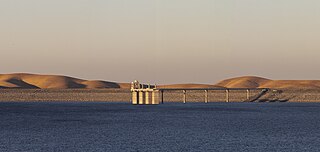
San Luis Dam, also known as B.F. Sisk Dam, is a major earth-filled dam in Merced County, California, which forms San Luis Reservoir, the largest off-stream reservoir in the United States. The dam and reservoir are located in the Diablo Range to the east of Pacheco Pass and about 10 miles (16 km) west of Los Banos. San Luis Dam, a jointly-owned state and federal facility, stores more than 2 million acre feet (2.5 km3) of water for the California State Water Project and the federal Central Valley Project. Although the dam is located in the valley of San Luis Creek, the majority of its water comes from man-made aqueducts which are supplied from other rivers in Northern California.
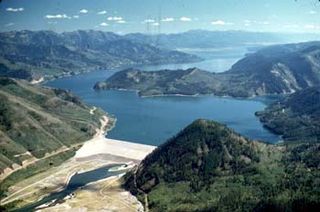
Palisades Dam is an earth-fill dam in the western United States, on the upper Snake River in eastern Idaho. Located in Bonneville County near the Wyoming border, the dam was completed 67 years ago in 1957.

Nagarjuna Sagar Dam is a masonry dam across the Krishna River at Nagarjuna Sagar which straddles the border between Palnadu district in Andhra Pradesh and Nalgonda district in Telangana. The dam provides irrigation water to the districts of Palnadu, Guntur, Nalgonda, Prakasam, Khammam, Krishna, and parts of West Godavari. It is also a source of electricity generation for the national grid.

Run-of-river hydroelectricity (ROR) or run-of-the-river hydroelectricity is a type of hydroelectric generation plant whereby little or no water storage is provided. Run-of-the-river power plants may have no water storage at all or a limited amount of storage, in which case the storage reservoir is referred to as pondage. A plant without pondage is subject to seasonal river flows, so the plant will operate as an intermittent energy source. Conventional hydro uses reservoirs, which regulate water for flood control, dispatchable electrical power, and the provision of fresh water for agriculture.
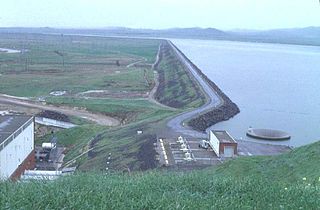
O'Neill Forebay is a forebay to the San Luis Reservoir created by the construction of O'Neill Dam across San Luis Creek approximately 12 miles (19 km) west of Los Banos, California, United States, on the eastern slopes of the Pacific Coast Ranges of Merced County.
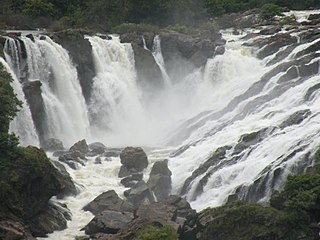
India is 5th globally for installed hydroelectric power capacity. As of 31 March 2020, India's installed utility-scale hydroelectric capacity was 46,000 MW, or 12.3% of its total utility power generation capacity. Additional smaller hydroelectric power units with a total capacity of 4,683 MW have been installed. India's hydroelectric power potential is estimated at 148,700 MW at 60% load factor. In the fiscal year 2019–20, the total hydroelectric power generated in India was 156 TWh with an average capacity factor of 38.71%.

The Bhumibol Dam is a concrete arch dam on the Ping River, a tributary of the Chao Phraya River, in Sam Ngao District of Tak Province, Thailand. It is about 480 km (298 mi) north of Bangkok and was built for the purposes of water storage, hydroelectric power production, flood control, fisheries and saltwater intrusion management. The dam was named after King Bhumibol Adulyadej and it was Thailand's first multi-purpose project. It is the highest dam in Thailand at 154 m (505 ft) tall.
The Bailianhe Pumped Storage Power Station is a pumped-storage hydroelectric power station located 58 kilometres (36 mi) east of Huanggang in Hubei Province, China. It was constructed between 2004 and 2010 and has a 1,200 megawatts (1,600,000 hp) installed capacity. The power station operates by shifting water between an upper and lower reservoir to generate electricity. For this project, only the upper reservoir had to be created as an existing reservoir, the Bailianhe Reservoir, was used as the lower. During periods of low energy demand, such as at night, water is pumped from Bailianhe Reservoir up to the upper reservoir. When energy demand is high, the water is released back down to the lower reservoir but the pump turbines that pumped the water up now reverse mode and serve as generators to produce electricity. The process is repeated as necessary and the plant serves as a peaking power plant.
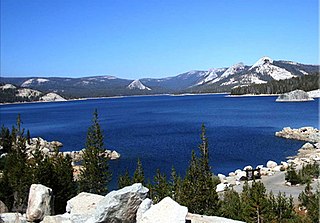
The Helms Pumped Storage Plant is located 50 mi (80 km) east of Fresno, California in the Sierra Nevada Mountain Range's Sierra National Forest. It is a power station that uses Helms Creek canyon on the North Fork of the Kings River for off-river water storage and the pumped-storage hydroelectric method to generate electricity. After being planned in the early 1970s, construction on the plant began in June 1977 and commercial operations began on 30 June 1984. It has an installed capacity of 1,212 MW and is owned by Pacific Gas and Electric Company.
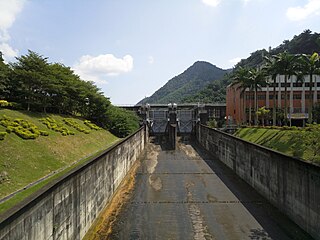
The Minghu Dam (Chinese: 明湖水壩; pinyin: Mínghú Shuǐbà, renamed the Takuan Dam, is a concrete gravity dam on the Shuili River located 7 km north of Shuili Township in Nantou County, Taiwan. The reservoir formed by the dam serves as the lower reservoir for the Minhu Pumped Storage Hydro Power Station. Sun Moon Lake serves as the upper reservoir.

The Żarnowiec Pumped Storage Power Station is a pumped-storage power station located about 7 km (4.3 mi) south of Żarnowiec, in Puck County, northern Poland. It was constructed between 1973 and 1983 and underwent a modernisation between 2007 and 2011, with the upper reservoir reconstructed in 2006.
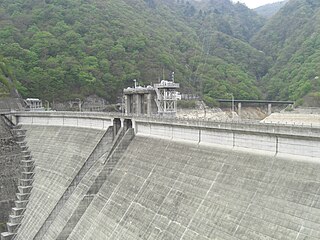
The Shiobara Pumped Storage Power Station (塩原発電所) is a pumped-storage hydroelectric power station in Nasushiobara, in the Tochigi Prefecture of Japan. It has a total installed capacity of 900 megawatts (1,200,000 hp). The power plant started operation in 1994.

The Imaichi Pumped Storage Power Station is a large pumped-storage hydroelectric power station in Tochigi Prefecture, Japan. With a total installed capacity of 1,050 megawatts (1,410,000 hp), it is one of the largest pumped-storage power stations in Japan. The facility is run by the Tokyo Electric Power Company (TEPCO). The power plant started operation in July 1988 with a capacity of 350 MW. The other two units entered operation in December 1991. The plant is one of the many large scale pure pumped-storage plants built in Japan since the 1970s to compensate for the increased penetration of base-load nuclear power and peak load from cooling and air-conditioning.


















